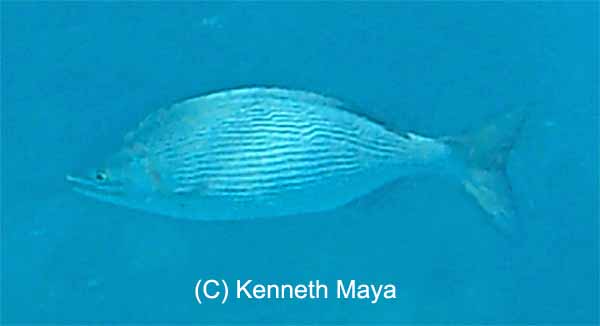Kyphosus sectatrix
(Linnaeus, 1758)
|
Familie: Kyphosidae SynonymePerca saltatrix Linnaeus, 1758
Pimelepterus oblongior Cuvier, 1831 Lokale Bezeichnung |
Typen
Neotypus: USNM 116963
Typusfundort: Dry Tortugas Island, Golf von Mexiko, Florida, USA.
Etymologie
Der Name sectatrix basiert ausschließlich auf Catesby (1743: 8, Pl. 8, Abb. 2 (2)). Catesbys Name sectatrix basiert auf dem lateinischen "Verfolger", auf den er in seiner Darstellung anspielte. Anscheinend war salatrix Linnaeus 1758 ein Lapsus, den er selbst im Jahre 1766 zu sectatrix veränderte. Frühe Autoren wie Jordan & Everman (1898: 1387) verwendeten sectatrix für diese Art, genauso wie die meisten nachfolgenden Autoren. In jüngerer Zeit verwenden einige Autoren sectator. In jedem Fall kann der Name saltatrix wegen mangelnder Verwendung ausgeschlossen werden, oder er kann als eine falsche Originalschreibweise betrachtet werden, die Linnaeus im Jahre 1766 korrigiert hat. Die Namen sectatrix und sectator sind dann im Wettbewerb, aber der Name sectatrix ist ein Substantiv und muss in der Verwendung von Linnaeus im Jahre 1776 und von Jordan & Evermann in Kyphosus nicht geändert werden. Die Schreibweis saltator ist die männliche Form von saltatrix, deshalb verwendeten manche Leute also diese, als die Spezies in Kyphosus platziert wurde. Der richtige Name ist aber Kyphosus sectatrix (Linnaeus, 1758). (sinngemäß übersetzt aus Catalog of Fishes)
Verbreitung
Westliches Mittelmeer (selten), Ost- und Westatlantik, Indo-Pazifik.
IUCN Status

CR Critically Endangered (vom Aussterben bedroht)
EN Endangered (stark gefährdet)
VU Vulnerable (gefährdet)
NT Near Threatened (potenziell gefährdet)
LC Least Concern (nicht gefährdet)
RE Regionally Extinct (regional oder national ausgestorben)
DD Data Deficient (ungenügende Datengrundlage)
NE Not Evaluated (nicht beurteilt)
Status: Stand 21.04.2017: LC Least Concern (nicht gefährdet)
Grund für die Gefährdungseinstufung: Es gibt keine großen Bedrohungen für Kyphosus sectatrix.
Literatur
- Catesby, M. 1731-1743. The natural history of Carolina, Florida and the Bahama Islands : Containing the figures of birds, beasts, fishes, serpents, insects, and plants: particularly the forest-trees, shrubs, and other plants, not hitherto described, or very incorrectly figured by authors. Together with their descriptions in English and French. To which, are added observations on the air, soil, and waters: with remarks upon agriculture, grain, pulse, roots, & c. To the whole, is prefixed a new and correct map of the countries treated of. London. 2 Bände. Zitatseite [: ]
- Linnaeus, C. 1758. Systema naturae per regna tria naturae, secundum classes, ordines, genera, species, cum characteribus, differentiis, synonymis, locis. Editio Decima, Reformata. Tomus I. Laurentii Salvii, Stockholm. 824 pp. (doi) Zitatseite [: , als Perca saltatrix]
- Linnaeus, C. 1766. Systema naturae sive regna tria naturae, secundum classes, ordines, genera, species, cum characteribus, differentiis, synonymis, locis. Laurentii Salvii, Holmiae. 12th ed. 1 (1): 1-532. Zitatseite [: 486, als Perca sectatrix]
- Döderlein, P. 1883. Rinvenimento di una specie di pesce dell’esotico genere Pimelepterus, Lac. nelle acque del Golfo di Palermo. Il Naturalista Siciliano, 3: 81–86. Zitatseite [: Fig. 1, Golf von Palermo, Sizilien]
- Ariola, V. 1904. Pesci nuovi o rari per il Golfo di Genova. Annali del Museo Civico di Storia Naturale di Genova, 3 (1): 153–168. Zitatseite [: , Golf von Genua, Italien]
- Šoljan, T. 1963. Fishes of the Adriatic (Ribe Jadrana). NOLIT Publ. House, Belgrade, 428 pp. Zitatseite [: , Trieste, Italien, Fang von 1846]
- Whitehead, P.J.P., Bauchot, M.-L., Hureau, J.-C., Nielsen, J. & Tortonese, E. 1986. Fishes of the North-eastern Atlantic and the Mediterranean. Volume II. pp. 517-1007. Paris: Unesco, 1986. Zitatseite [: 913, Zeichnung, Kurzbeschreibung, Verbreitung, als Kyphosus sectator]
- Costa, F. 1991. Atlante dei pesci dei mari italiani. Verlag: Mursia, Milano. Zitatseite [: 246f, Farbfoto, Kurzbeschreibung, als Kyphosus sectator]
- Merella, P., Massutí, E. & Deudero, S. 1998. On the occurrence of Kyphosus sectator (Osteichthyes: Kyphosidae) in the western Mediterranean. Journal of the Marine Biological Association of the United Kingdom, 78 (2): 687–690. (doi) Zitatseite [: , Mallorca, Spanien]
- Bañon, R. 2004. New records of two Southern fish in Galician waters (NW Spain). Cybium, 28 (4): 367-368. (PDF) Zitatseite [: 367f, Fundort: Galicien]
- Hemida, F., Kanoun, N., Golani, D., Ben Souissi, J., Guélorget, O. & Capapé, C. 2004. Records of the Bermuda sea chub, Kyphosus sectator (Linnaeus, 1758) (Osteichthyes: Kyphosidae) from the coastal waters of Algeria (southern Mediterranean). Annales, Series Historia Naturalis, 14 (1): 49–52. Zitatseite [: , Annaba, Algerien, als Kyphosus sectator]
- Hattour, A. 2006. Première observation de la calicagère blanche Kyphosus sectatrix (Linnaeus, 1758) sur les côtes Tunisiennes. Bulletin de l'Institut National des Sciences et Technologies de la Mer de Salammbô, 33: 123–125. Zitatseite [: , Salakta, Tunesien]
- Francour, P. & Mouine, N. 2008. First record of Kyphosus sectator (Kyphosidae) along the French Mediterranean coast. Cybium, 32 (3): 275–276. Zitatseite [: , Saint-Tropez, Frankreich, als Kyphosus sectator]
- Lelong, P. 2012. A new record of Bermuda sea chub, Kyphosus saltatrix (Linnaeus, 1758) (Osteichthyes, Kyphosidae) from Galite Islands (Tunisia, southern Mediterranean). Marine Life, 18 (1): 3–7. (PDF) Zitatseite [: , Galite Islands, Tunesien]
- Ligas, A., Sartor, P., Sbrana, M. & De Ranieri, S. 2011. A new record of Kyphosus saltatrix (Pisces: Kyphosidae) along the Italian coasts (north-western Mediterranean). Marine Biodiversity Records, 4: e6. (doi) Zitatseite [: , (Livorno, Italien) Kyphosus saltatrix -->Kyphosus vaigiensis]
- Elbaraasi, H., Bograra, O., Elsilini, O. & Bojwari, J. 2013. First record of the Bermuda sea chub, Kyphosus saltatrix (Actinopterygii: Perciformes: Kyphosidae), in the coastal waters of Libya. Acta Ichthyologica et Piscatoria, 43 (3): 251–253. (doi) Zitatseite [: , Benghazi, Libyen, als Kyphosus saltatrix]
- Kiparissis, S., Loukovitis, D. & Batargias, C. 2012. First record of the Bermuda sea chub Kyphosus saltatrix (Pisces: Kyphosidae) in Greek waters. Marine Biodiversity Records, 5: e11. (doi) Zitatseite [: , Strofades Islands, Griechenland, als Kyphosus saltatrix]
- Lo Brutto, S. 2017. The Case of a Rudderfish Highlights the Role of Natural History Museums as Sentinels of Bio-invasions. Zootaxa, 4254 (3): 382–386. (doi) Zitatseite [: 384f, Fänge im Mittelmeer]
